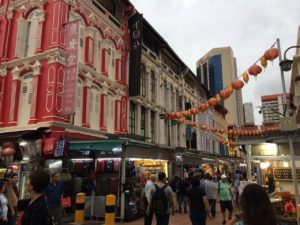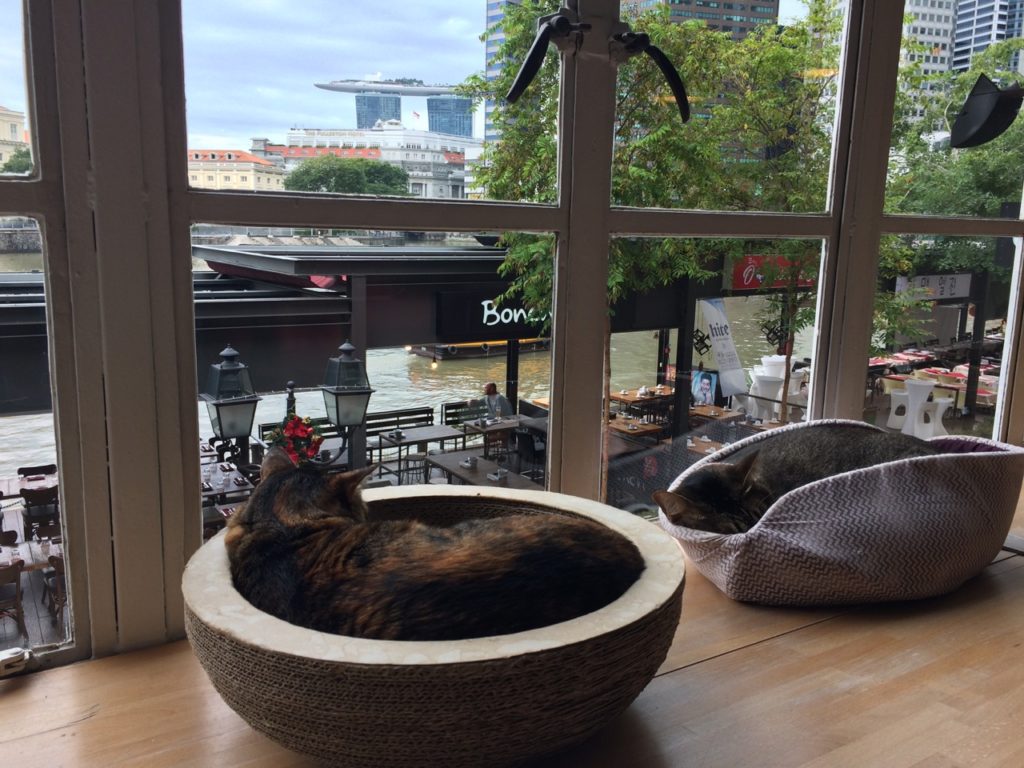What to say about Singapore? It’s an unquestionably beautiful city, made that way by culture and climate and wealth, draped with garden vines and sprinkled with green open spaces offsetting a pleasing combination of colorful, classic architecture mixed with ultra-modern glass high-rises and mega-malls. Broad, well-paved, tree-lined boulevards arc through the low hills, weaving among garden stores and restaurants, the occasional mansion peering through the manicured jungle.
It’s surprisingly affordable, apart from housing, and the people were unfailingly polite and friendly—friendlier even than Bangkok, where a certain bored apathy often overtakes the land of smiles, and clerks and shopkeepers sometimes act as if you’re simply an obstacle between them and more screen time with their cellphone. Though Singapore is ranked #1 among smartphone adoption worldwide, there was none of that here. I don’t think any clerk or server failed to smile and thank me for my business.
It’s known as a strict, rigid city-state, a democracy with many of the conventional democratic freedoms curtailed… “Disneyland with the Death Penalty” as William Gibson once put it.
Gibson saw a draconian police-state dedicated to taking all the edges off, to reducing cultural dissent and expression into formulaic output designed to avoid introducing any unwelcome complications into the thundering economic machine the island had become. He lamented the lack of nightlife, the oppressive authoritarian niceness, the bland music and arts scene… a sort of acceptably commercialized utopia with the creativity stamped out of it to reduce disharmony.
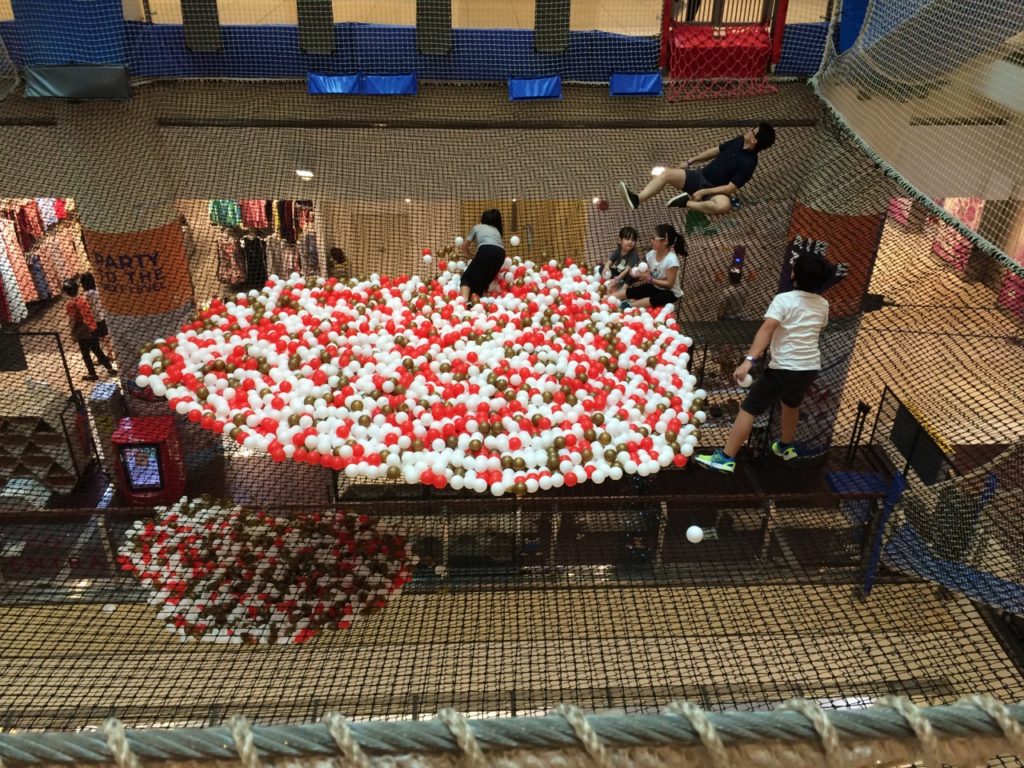
Either it’s changed a lot or he didn’t walk the streets of Little India on his visit. An adult entertainment store sat alongside open air restaurants, 24-hour shops selling dubious electronics, and music blared well into the late hours from suspiciously lit places with the shutters closed across the street. Heck, there was trash in the gutters.
Or, perhaps the thesis of his essay (if it had a thesis) was right, and the Internet, having stampeded wholesale onto the island in the interval between our visits, has genuinely changed the place.

Coming away after only a longish weekend of the place, my perspective may be similarly uninformed. But the history, which Gibson goes into briefly, seems to me to explain a lot about the approach the government has taken–indeed, has been constitutionally mandated to take, in many cases–to ensuring multicultural harmony in a vividly disparate collection of traditions.
It all rings strangely to anyone from the melting pot countries, where a sameness of culture carries much of the burden for producing inter-cultural harmony. Singapore’s approach doesn’t strike me as the best one, but it’s aimed at a similar problem, and the jury is still out on how well the American experiment, and others in the same vein, have actually run.
There’s a tendency, perhaps a universal one but surely common among American’s generally and myself in particular, to default to the assumption that our system is the best system, and to evaluate others primarily in the ways where they fail on that scorecard. Singapore, with its sometime draconian legal system, has much to pick at for anyone reared on American exceptionalism.
Yet it’s a functioning democracy, with a voter turnout reliably over 90 percent (a number that puts ours to shame), so those laws at least have the overwhelming approval of a multicultural society. And if American government ran so effectively, would our rancorous voters be inclined to flip political control as frequently as we do?
I don’t have answers, right or wrong. But it is another in a series of examples to me that there are any number of ways to organize and run governments and societies in this world that people end up being generally okay with (Thailand’s compassionately libertarian system of corruption being another… at least for now).
Anyway, I didn’t spend the trip meditating on politics or good governance–I went to see the sights. And the sights, for the most part, are outdoors.
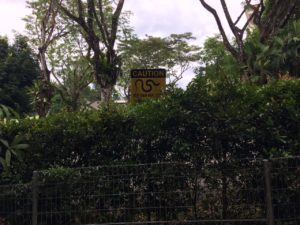
Manicured though it may be, Singapore’s small remaining slices of jungle felt more jungly to me than anywhere else I have been in Southeast Asia. Granted, I try to stay out of the boondocks, but have been to several Thai national parks in various parts of the country. All of them were more crowded than Singapore’s Central Water Catchment, despite the comparative size and populations of the countries. That may have something to do with the apparently abundant wildlife we saw in and along the Tree Top Walk there, despite the ever-present reminders that we were, in fact, in the middle of a teeming city-state island.
We took a bus to the park, following our AI overlord’s directions. These proved to be imperfect, trying to take us down a lonely access road without sidewalks that would have been boring hiking indeed, but we stopped and looked at the map and thought for ourselves for a moment and found a nearby trailhead instead.
Not twenty yards in from the busy street, I glimpsed a small boar rooting through the undergrowth just off the trail. A couple hundred yards past that, a large lizard commandeered the path for a minute or so, the first of many of them we would see on and around the hike. Squirrels darted through the limbs and birds and insects chattered all around. Macaques went up and down trees and hung upside down overhead as if gravity simply didn’t matter while they groomed one another or searched for food.
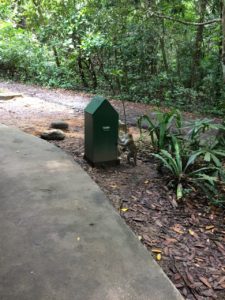
It was sweltering, with a rare breath of breeze sneaking down the trail every once in a while to provide ever-so-slight relief. Two kilometers in, we reached a small ranger station near the tree-top walk where there was a drinking fountain. A medium-sized macaque was investigating the secure garbage can there, scaling a small sapling behind it with practiced technique to gain access to the lid. While he was working out how to get it open, a couple of the park maintenance personnel came around a corner pushing a cart. The monkey dropped to the ground immediately and began casually looking around in other directions–anywhere but toward the garbage bin. I could almost hear him whistling innocently as the workers walked past.
If I had thought about it ahead of time, I would have realized that getting to a tree top walk would necessitate some climbing… to the top, no less, of some trees. But having failed to consider this, I found myself some three kilometers in and faced with a hike up a hill to the entry to the bridge. It was strung, sensibly, across a valley, so access was from either ridge line.
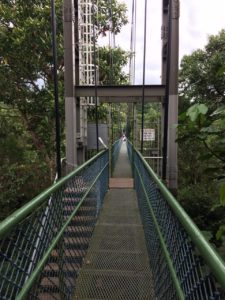 We were glad of the slog up the hill once we stepped out onto the slightly swaying bridge deck. Finally, yards above the foliage, a cool breeze jetted past, blowing the sweat away. Down below, birds flitted through the canopy and we were mercifully spared any sightings of the flying snakes that various signs posted warnings about.
We were glad of the slog up the hill once we stepped out onto the slightly swaying bridge deck. Finally, yards above the foliage, a cool breeze jetted past, blowing the sweat away. Down below, birds flitted through the canopy and we were mercifully spared any sightings of the flying snakes that various signs posted warnings about.
Instead, it was on the boardwalk on the other side of the tree walk that we encountered the snake.
Like a submarine raising its periscope, his head emerged from the gap between the slats about ten feet in front of us, took a leisurely spin to survey the terrain, and then slithered out onto the walk… fortunately headed in the opposite direction. I froze in place and managed to not wet my pants while we gave him plenty of time to get wherever he was going.
After that encounter, I was ready to get back to the concrete jungle.

Museums are reliably air conditioned so we went to a couple of them: the National Museum and the National Gallery. I found myself wishing I had had more time to wander around; we didn’t end up catching everything in the National Gallery, even discounting the fact that Microsoft had taken over the upper floor for some event or another.
But even after museums close, there’s always the mall. Like every other Asian country, Singapore is overrun with them. We went to a couple, including one near our hotel that had a sort of multi-level bouncy-ball playground suspended in the airy spaces between the floors, putting American malls to shame.
In the intervals, when the heat was bearable, we walked around and enjoyed the street food. It’s not actually on the street, Singapore being too tidy for any such rowdiness, but instead in large, open-air buildings that amount basically to food malls. In one of them, in Chinatown, you can get the world’s cheapest Michelin-starred meal, a bowl of noodle’s for a buck and a half U.S.
The locals eat out as much as they do in Bangkok, but concentrated in these massive eateries, so the tiny little spaces are seriously industrial kitchen spaces–they turn out a lot of food during meal times.
For a more relaxing space to hang out in, we visited a local cat cafe. We’re both big fans of the Caturday Cafe in Bangkok, so we thought we’d try out something to compare it to: Cafe Neko No Niwa, on Boat Quay along the Singapore River. The experience was… very Singaporean.
In contrast to the Caturday, you have to pay a flat fee to enter the cat room. Supervision is intense: three employees keep a watchful eye on you the entire time you are inside. There are only a handful of cats, all of them rescues, and during our visit, their sole preoccupation was on the door to the outside world. They had the look and behavior of the condemned, hoping against hope that the next escape attempt would be successful.
It was a bit sad, and perhaps because of that, it was fairly sparsely attended. Monica attempted futilely to attract the attention of the napping cats (although not too fervently, it being against the rules to wake a sleeping cat), and we finished our drinks and left.
And I guess that was pretty much our Singapore visit in a nutshell. Although it’s an attractive, organized, friendly, and interesting place, there’s just something a little bland about it… just a lot of people getting up, going to work, buying phone accessories, and doing it all again the next day. Not even the trash in the streets really livens it up.
A lot of times, when I visit someplace new and charming, I find myself looking up the cost of apartments, checking out phone plans, thinking about other things I’d like to explore if I was there longer… a few weeks, a few months. But with Singapore, I didn’t bother. It wouldn’t bother me to go back again, but I probably wouldn’t make a point of it.
I guess Gibson was right after all!


